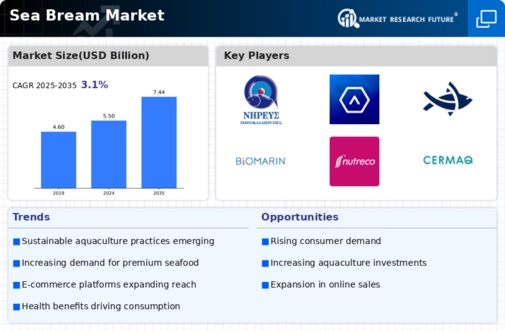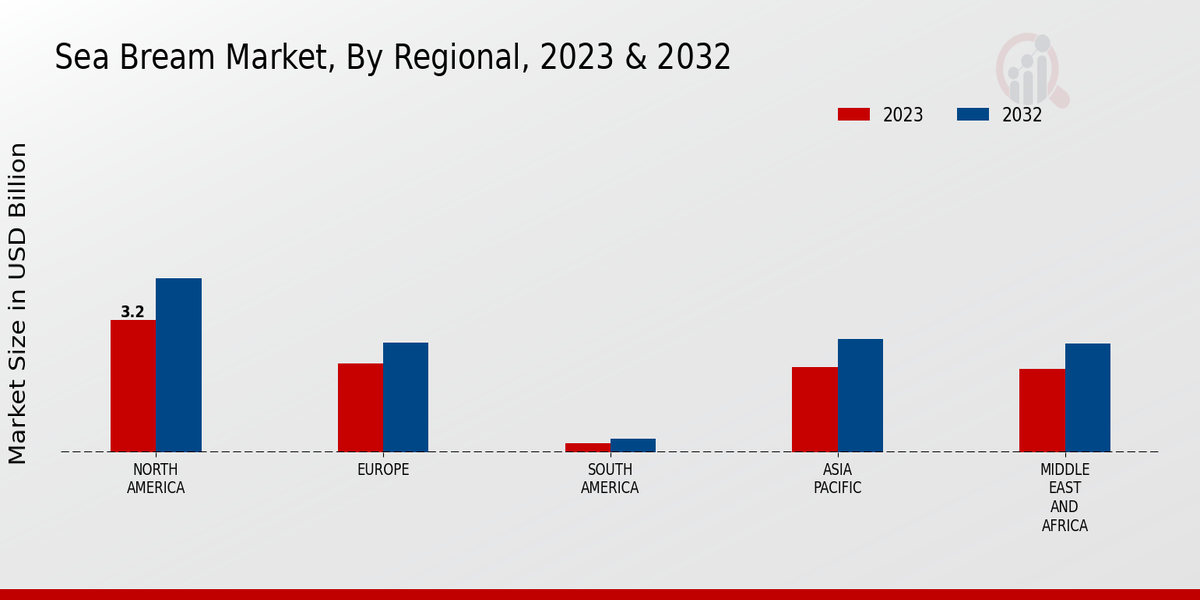Rising Consumer Demand
The Global Sea Bream Market Industry experiences a notable increase in consumer demand, driven by the growing awareness of health benefits associated with seafood consumption. Sea bream is recognized for its high protein content and omega-3 fatty acids, which are essential for maintaining a balanced diet. As consumers become more health-conscious, the preference for nutritious food options continues to rise. In 2024, the market is projected to reach 5.5 USD Billion, reflecting this trend. The increasing popularity of Mediterranean cuisine, which prominently features sea bream, further fuels this demand, indicating a robust growth trajectory for the industry.
Market Growth Projections
The Global Sea Bream Market Industry is projected to experience steady growth over the coming years. In 2024, the market value is estimated at 5.5 USD Billion, with expectations to reach 7.44 USD Billion by 2035. This growth trajectory suggests a compound annual growth rate (CAGR) of 2.79% from 2025 to 2035. Such projections indicate a stable demand for sea bream, driven by factors such as increasing consumer awareness of health benefits, sustainable farming practices, and technological advancements in aquaculture. The industry appears well-positioned to capitalize on these trends, ensuring its relevance in the global seafood market.
Growing Export Opportunities
The Global Sea Bream Market Industry is poised for growth due to expanding export opportunities. Countries with established aquaculture sectors are increasingly targeting international markets, capitalizing on the rising global demand for seafood. Regions such as Europe and Asia are significant importers of sea bream, creating lucrative opportunities for producers. As trade agreements evolve and logistics improve, the potential for exporting sea bream products is likely to increase. This trend not only supports local economies but also contributes to the industry's overall growth, with projections indicating a market value of 7.44 USD Billion by 2035.
Sustainable Aquaculture Practices
Sustainability is a pivotal factor influencing the Global Sea Bream Market Industry. The adoption of sustainable aquaculture practices is gaining momentum as consumers and regulatory bodies prioritize environmentally friendly production methods. This shift not only addresses ecological concerns but also enhances the marketability of sea bream products. As a result, producers are increasingly investing in technologies that promote responsible farming practices. The industry's commitment to sustainability is likely to attract a broader consumer base, potentially leading to an increase in market value. This trend aligns with the projected growth of the market, expected to reach 7.44 USD Billion by 2035.
Expansion of Distribution Channels
The expansion of distribution channels significantly impacts the Global Sea Bream Market Industry. With the rise of e-commerce and online grocery shopping, consumers have greater access to fresh seafood products, including sea bream. Retailers are increasingly adopting omnichannel strategies to reach a wider audience, thereby enhancing market penetration. This trend is particularly relevant in urban areas where demand for convenient shopping options is high. As distribution networks become more efficient, the availability of sea bream is expected to increase, further driving market growth. This accessibility aligns with the industry's projected market value of 5.5 USD Billion in 2024.
Technological Advancements in Farming
Technological advancements in aquaculture are transforming the Global Sea Bream Market Industry. Innovations such as automated feeding systems, water quality monitoring, and genetic improvements in breeding are enhancing production efficiency and fish health. These advancements not only reduce operational costs but also improve the overall quality of sea bream, making it more appealing to consumers. As the industry embraces these technologies, it is likely to witness a steady growth rate, with a projected CAGR of 2.79% from 2025 to 2035. This technological evolution positions the industry favorably in a competitive market, ensuring a consistent supply of high-quality sea bream.
















